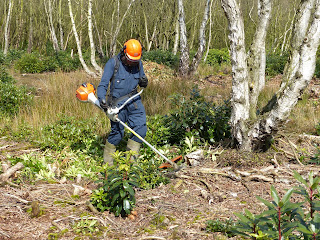Last week the team visited the local heronry to undertake the first
series of nest counts and to check on breeding success. A total of 24 active
nests were counted, which is a little down on recent years, although it appears
to be a rather late season so there is time yet. Whilst checking the nests we
managed to take a few quick photographs from the tree tops – pictured here is a
very young heron chick, and a clutch of four eggs. We had been expecting to be
able to ring some of the young but it soon became clear that most of the chicks
were too small – with some just hatching and several adults still incubating
clutches. After a quick check of a sample of nests we departed to allow the
adults to get back to incubating and brooding – fingers crossed the cold
nights, and snow and hail won’t have caused them too many problems during the
last few days – hopefully the weather will take a turn for the better soon...



Along with monitoring the heron population, we're also on the look out for any of our colour-ringed Whimbrel. The first returning birds touched down
in the Lower Derwent Valley on Saturday 16th April, with three individuals seen flying
over Bank Island late evening. A brief stop at the fields in Storwood on Monday
revealed another two birds (neither with colour-rings). Each year we look
forward to seeing these remarkable birds passing through the reserve which they
use as a spring staging site.
Over 100 birds have been colour-ringed at the Wheldrake
roost since 2004, and since then 75% of these birds have been re-sighted in subsequent
years around the valley. Last year new recovery details came in for two birds,
with one individual seen on autumn passage on the Ythan Estuary, Aberdeenshire,
for the third year (pictured below), followed by a second individual that had
been photographed wintering off the Senegal coast. Please let us know if you
come across any colour-ringed birds in and around the valley (or elsewhere),
and feel free to get in touch if you think that a group that you’re part of
might like to hear a talk on our Whimbrel or any other wildlife from the LDV.

With the (brief spell) of warm sunshine last week it finally felt like spring
had arrived, our returning summer migrants – Swallows and House Martins, filled
the skies above the local villages whilst Willow Warblers, Whitethroats and
Blackcaps sang from the willow scrub around the reserve. At this time of year Wheatears also pass through the area on the way to their breeding
sites in Northern England and Scotland, and onwards to Iceland. They often
favour the flood banks of the River Derwent, tilled arable fields and muck heaps
which provide plenty of flies and grubs for them to refuel with. This male was
photographed with plenty of prey buzzing around it, near Thornton Ellers last
week.
















